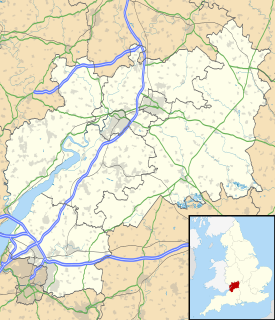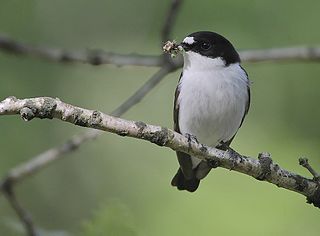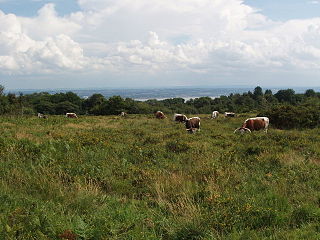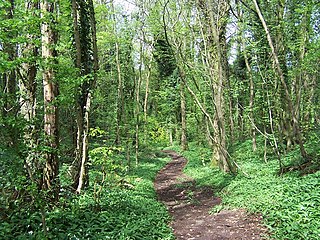
Sylvan House Barn is a 0.005-hectare (0.012-acre) stone built barn near the village of St Briavels, in the Forest of Dean, Gloucestershire. Because of its breeding bats, the site was notified as a biological Site of Special Scientific Interest in 1995.

Swanpool Wood and Furnace Grove is a 13.59-hectare (33.6-acre) biological Site of Special Scientific Interest, in Gloucestershire in South West England. The site is listed in the 'Forest of Dean Local Plan Review' as a Key Wildlife Site (KWS).

Lower Wye Gorge is a 65-hectare (160-acre) biological and geological Site of Special Scientific Interest in Gloucestershire, notified in 1954 and renotified 1987. The site includes two Gloucestershire Wildlife Trust nature reserves being Ban-y-gor Wood and Lancaut. The Natural England citation states a revision for Lancaut inclusion.

Nagshead is a 120.12-hectare (296.8-acre) biological Site of Special Scientific Interest and is located near Parkend, in the Forest of Dean, Gloucestershire, and was notified in 1972. It lies within the Forest of Dean Forest Park and is part held as a reserve by the Royal Society for the Protection of Birds (RSPB). The SSSI is a relatively small area of the much larger nature reserve of RSPB Nagshead, which is a 1,250 acres (510 ha) site owned and managed by the RSPB and the Forestry Commission. The SSSI lies to the east of the Nagshead Plantation and consists of two units of assessment by Natural England.

Astridge Wood is a 19.42-hectare (48.0-acre) biological Site of Special Scientific Interest in Gloucestershire, England, notified in 1985. The site is listed in the 'Forest of Dean Local Plan Review' as a Key Wildlife Site (KWS).

Bigsweir Woods is a 48.16-hectare (119.0-acre) biological Site of Special Scientific Interest in Gloucestershire, notified in 1984. The site is listed in the 'Forest of Dean Local Plan Review' as a Key Wildlife Site (KWS).

Brooks Head Grove is an 11.9-hectare (29-acre) biological Site of Special Scientific Interest in Gloucestershire, notified in 1986. The site is listed in the 'Forest of Dean Local Plan Review' as a Key Wildlife Site (KWS).

Buckshraft Mine & Bradley Hill Railway Tunnel is a 5.66-hectare (14.0-acre) biological Site of Special Scientific Interest in Gloucestershire, notified in 1998. This site comprises two separate locations. One is Buckshraft Mine which is near the village of Ruspidge. The other location is Bradley Hill Railway Tunnel which is near the village of Soudley.

Caerwood And Ashberry Goose House is a 0.01-hectare (0.025-acre) biological Site of Special Scientific Interest in Gloucestershire, notified in 1991. The site was previously notified as Caerwood, Tidenham and lies within the Wye Valley Area of Outstanding Natural Beauty.

Devil's Chapel Scowles is a 44.79-hectare (110.7-acre) biological Site of Special Scientific Interest in Gloucestershire, notified England, in 1998. The site lies in the Forest of Dean and has four units of assessment by Natural England.

Dingle Wood is a 9.95-hectare (24.6-acre) biological Site of Special Scientific Interest in Gloucestershire, notified in 1972. The site is listed in the 'Forest of Dean Local Plan Review' as a Key Wildlife Site (KWS). The wood is located within the Forest of Dean Forest Park and the Wye Valley Area of Outstanding Natural Beauty.

Edgehills Quarry is a 0.4-hectare (0.99-acre) geological Site of Special Scientific Interest in Gloucestershire, notified in 1974.

Old Bow And Old Ham Mines is a 40.3-hectare (100-acre) biological Site of Special Scientific Interest in Gloucestershire, notified in 1998.

Pennsylvania Fields, Sedbury is a 27.03-hectare (66.8-acre) biological Site of Special Scientific Interest in Gloucestershire, notified in 1985.

Poor's Allotment is a 28.57-hectare (70.6-acre) biological Site of Special Scientific Interest in Gloucestershire, notified in 1954. The site is listed in the 'Forest of Dean Local Plan Review' as a Key Wildlife Site (KWS).

Scully Grove Quarry is a 0.4-hectare (0.99-acre) geological Site of Special Scientific Interest in Gloucestershire, England, notified in 1974.

Shorn Cliff And Caswell Woods is a 69.2-hectare (171-acre) biological Site of Special Scientific Interest in Gloucestershire, notified in 1986. The site is listed in the 'Forest of Dean Local Plan Review' as a Key Wildlife Site (KWS).

The Hudnalls is a 94.4-hectare (233-acre) biological Site of Special Scientific Interest in Gloucestershire, notified in 1972. The site is listed in the 'Forest of Dean Local Plan Review' as a Key Wildlife Site (KWS).

Westbury Brook Ironstone Mine is a 15.69-hectare (38.8-acre) biological Site of Special Scientific Interest in Gloucestershire, notified in 1998.

Wigpool Ironstone Mine is a 34.88-hectare (86.2-acre) biological Site of Special Scientific Interest in Gloucestershire, notified in 1998.














